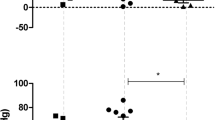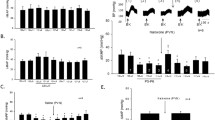Summary
Electrical stimulation and microinjections of the GABA antagonist bicuculline methiodide into the superior colliculus (SC) of the anaesthetized rat can evoke changes in blood pressure and heart rate. The long latency of bicuculline evoked responses, however, raises the possibility that they may have been produced by the diffusion of bicuculline to surrounding tissue, in particular, the periaqueductal gray. Thus, the purpose of the present study was to investigate whether such changes could have been produced by the activation of extracollicular neural elements. This was achieved by assessing the relative regional sensitivity of the SC and underlying structures (periaqueductal gray and dorsal tegmentum) with microinjections of the excitatory amino acid N-methyl D-aspartate (NMDA) for the production of short latency pressor responses. Dorsal midbrain injections of NMDA (200 nl of 100 mM) in the Saffan anaesthetized rat evoked clear short latency (single or double phase) increases in blood pressure accompanied in most cases by a longer latency increase in heart rate and respiration. Two regions within the dorsal midbrain contained significantly higher proportions of active sites compared with surrounding tissue: i) the superficial and intermediate layers of rostromedial SC, and ii) the caudal periaqueductal gray. The distribution of active sites indicated that pressor responses elicited from the rostromedial SC could not be explained by the diffusion of NMDA to underlying tissue. The question of whether the rostromedial SC might represent an early link in the circuitry responsible for organizing defensive movements and appropriate physiological changes to potentially dangerous overhead stimuli is considered.
Similar content being viewed by others
References
Abrahams VC, Hilton SM, Zbrozyna AW (1960) Active muscle vasodilatation produced by stimulation of the brain stem: its significance in the defence reaction. J Physiol (Lond) 154:491–513
Adams DB, Baccelli G, Mancia G, Zanchetti A (1969) Cardiovascular changes during naturally elicited fighting behaviour in the cat. Am J Physiol 216:1226–1235
Bandler R, Depaulis A, Vergnes M (1985) Identification of midbrain neurones mediating defensive behaviour in the rat by microinjection of excitatory amino acids. Behav Brain Res 15:07–119
Bandler R, McDougall A, Dampney R (1986) Behavioural and cardiovascular components of the defence reaction: role of the midbrain PAG. In: Oomura Y (ed) Emotions, neuronal and chemical control. Karger AG, Basel, pp 405–416
Bolme P, Ngai SH, Uvnäs B, Wallenberg LR (1967) Circulatory and behavioural effects of electrical stimulation of the sympathetic vasodilator areas in the hypothalamus and mesencephalon in unanesthetized dogs. Acta Physiol Scand 70:334–346
Carrive P, Dampney RAL, Bandler R (1987) Excitation of neurones in a restricted portion of the midbrain PAG elicits both behavioural and cardiovascular components of the defence reaction in the unanaesthetised decerebrate cat. Neurosci Lett 81:273–278
Chalupa LM (1984) Visual physiology of the mammalian superior colliculus. In: Vanegas H (ed) Comparative neurology of the optic tectum. Plenum, New York Press, pp 775–818
Ching M (1984) Comparison of the effects of althesin, chloraloseurethane, urethane and pentobarbital on mammalian physiologic responses. Can J Physiol Pharmacol 62:654–657
Coote JH, Hilton SM, Zbrozyna AW (1973) The ponto-medullary area integrating the defence reaction in the cat and its influence on muscle blood flow. J Physiol (London) 229:257–274
Dean P, Redgrave P (1984a) The superior colliculus and visual neglect in the rat and hamster. I Behavioural evidence. Brain Res Rev 8:129–141
Dean P, Redgrave P (1984b) The superior colliculus and visual neglect in the rat and hamster. III. Functional implications. Brain Res Rev 8:155–163
Dean P, Redgrave P, Sahibzada N, Tsuji K (1986) Head and body movements produced by electrical stimulation of superior colliculus in rats: effects of interruption of crossed tectoreticulospinal pathway. Neuroscience 19:367–380
Dean P, Mitchell IJ, Redgrave P (1988b) Responses resembling defensive behaviour produced by microinjection of glutamate into superior colliculus of rats. Neuroscience 24:501–510
Dean P, Redgrave P, Westby GWM (1989) Event or emergency? Two response systems in the mammalian superior colliculus. Trends Neurosci 12:137–147
Depaulis A, Bandler RJ, Vergnes M (1989) Characterization of pretentorial periaqueductal grey matter neurons mediating intraspecific defensive behaviours in rat by microinjection of kainic acid. Brain Res 486:121–132
Drager UC, Hubel DH (1976) Topography of visual and somatosensory projections to mouse superior colliculus. J Neurophysiol 39:91–101
Fagg GE (1985) L-glutamate, excitatory amino acid receptors and brain function. Trends Neurosci 8:207–210
Fallon JH, Moore RY (1979) Superior colliculus efferents to the hypothalamus. Neurosci Lett 14:265–270
Flatman JA, Schwindt PC, Crill WE, Stafstrom CE (1983) Multiple actions of N-methyl D-aspartate on cat neocortical neurons in vitro. Brain Res 266:169–173
Fosse VF, Fonnum F (1986) Effects of Kainic acid and other excitotoxins in the rat superior colliculus: relations to glutaminergic afferents. Brain Res 383:28–37
Gatti PJ, Norman WP, Dasilva AMT, Gillis R (1986) Cardiorespiratory effects produced by microinjecting 1-glutamic acid into medullary nuclei associated with the ventral surface of the feline medulla. Brain Res 381:281–288
Gauthier P (1981) Pressor responses and adrenomedullary catecholamine release during brain stimulation in the rat. Can J Physiol Pharmacol 59:485–492
Gauthier P, Reader T (1982) Adrenomedullary secretory response to midbrain stimulation in rat: effect of depletion of brain catecholamines or serotonin. Can J Physiol Pharmacol 60:1464–1474
Goodchild AK, Dampney RAL, Bandler R (1982) A method for evoking physiological response by stimulation of cell bodies, but not axons of passage, within localized regions of the central nervous system. J Neurosci Meth 6:351–363
Graham FK, Clifton RK (1966) Heart rate change as a component of the orienting response. Psychol Bull 65:305–320
Herrling PL, Morris R, Salt T (1983) Effects of excitatory amino acids and their antagonists on membrane and action potentials of cat caudate neurones. J Physiol (Lond) 339:207–222
Herron CE, Lester RAJ, Coan EJ, Collingridge GL (1986) Frequency dependent involvement of NMDA receptors in the hippocampus: a novel synaptic mechanism. Nature 322:265–268
Hilton SM (1982) The defence arousal system and its relevance for circulatory and respiratory control. J Exp Biol 100:159–174
Hilton SM, Smith PR (1984) Ventral medullary neurones excited from the hypothalamic and midbrain defence areas. J Auton Nerv Syst 11:35–42
Hilton SM, Redfern WS (1986) A search for brain stem cell groups integrating the defence reaction in the rat. J Physiol 378:213–228
Jürgens U, Richter K (1986) Glutamate-induced vocalization in the squirrel monkey. Brain Res 373:349–358
Keay KA, Redgrave P, Dean P (1988) Cardiovascular and respiratory changes elicited by stimulation of rat superior colliculus. Brain Res Bull 20:13–26
Klockgether T, Schwartz M, Turski L, Sontag K-H (1986) The rat ventromedial thalamic nucleus and motor control: the role of N-methyl D-aspartate mediated excitation, GABAergic inhibition and muscarinic transmission. J Neuroscience 6:1702–1711
Krieger JE, Graeff FG (1985) Defensive behavior and hypertension induced by glutamate in the midbrain central grey of the rat. Braz J Med Biol Res 18:61–67
Li P, Lovick TA (1985) Excitatory projections from hypothalamic and midbrain defence region to nucleus paragigantocellularis in the rat. Exp Neurol 89:543–553
Lindgren P (1955) The mesencephalon and the motor system: an experimental study on the central control of peripheral blood flow in the cat. Acta Physiol Scand (Suppl) 121:1–189
Lindgren P, Rosén A, Strandberg P, Uvnäs B (1956) The sympathetic vasodilator outflow: a cortico-spinal autonomic pathway. J Comp Neurol 105:95–109
Lovick TA (1985) Ventrolateral medullary lesions block the antinociceptive and cardiovascular responses elicited by stimulating the dorsal PAG matter in rats. Pain 21:241–252
Lovick TA (1985) Descending projections from the ventrolateral medulla and cardiovascular control. Pflügers Arch 404:197–202
Mayer ML, Westbrook GL (1987) Cellular mechanisms underlying excitotoxicity. Trends Neurosci 10:59–61
McCrimmon DR, Feldman JL, Speck DF (1986) Respiratory motorneuronal activity is altered by injections of picomoles of glutamate into cat brainstem. J Neurosci 6:2384–2392
Northmore DPM, Levine ES, Schneider GE (1988) Behaviour evoked by electrical stimulation of the hamster superior colliculus. Exp Brain Res 73:595–605
Olney JW, Price MT, Shahid Salles K, Labruyere J, Ryerson R, Mahan K, Frierdich G, Samson L (1986) 1-homocysteic acid: an excitotoxic ligand of the NMDA receptor. Brain Res Bull 19:597–602
Paxinos G, Watson C (1982) The rat brain in stereotaxic coordinates. Academic Press, Sydney
Redgrave P, Dean P, Souki W, Lewis G (1981) Gnawing and changes in reactivity produced by microinjections of picrotoxin into the superior colliculus of rats. Psychopharmacology 75:198–203
Redgrave P, Dean P (1985) Tonic desynchronization of cortical electroencephalogram by electrical and chemical stimulation of superior colliculus and surrounding structures in urethaneanaesthetized rats. Neuroscience 16:659–671
Redgrave P, Mitchell IJ, Dean P (1987) Descending projections from the superior colliculus in rat: a study using orthograde transport of wheatgerm-agglutinin conjugated horseradish peroxidase. Exp Brain Res 68:147–167
Redgrave P, Dean P, Mitchell IJ, Odekunle A, Clark A (1988) The projection from the superior colliculus to cuneiform area in the rat. I. Anatomical studies. Exp Brain Res 72:611–625
Richter K, Jürgens U (1986) A comparative study on the elicitability of vocalization by electrical brain stimulation, glutamate, aspartate and quisqualate in the squirrel monkey. Neurosci Lett 66:239–244
Sahibzada N, Dean P, Redgrave P (1986) Movements resembling orientation or avoidance elicited by electrical stimulation of the superior colliculus in rats. J Neurosci 6:723–733
Salt TE (1986) Mediation of thalamic sensory input by both NMDA receptors and non-NMDA receptors. Nature 322:263–265
Schenberg LC, De Aguiar JC, Graeff FG (1983) GABA modulation of the defence reaction induced by brain electrical stimulation. Physiol Behav 31:429–437
Schramm LP, Bignall KE (1971) Central neural pathways mediating active sympathetic muscle vasodilation in cats. Am J Physiol 221:754–767
Smith OA, Clarke NP (1964) Central autonomic pathways: a study in functional neuroanatomy. J Comp. Neurol 122:399–406
Sokolov EN (1960) Neuronal models and the orienting reflex. In: Brazier MAB (ed) The central nervous system and behaviour. Josiah Macy Jnr. Foundation, New York. Vol 3: pp 187–276
Stone TW, Burton NR (1988) NMDA receptors and ligands in the vertebrate CNS. Prog Neurobiol 30:333–368
Tiao Y-C, Blakemore C (1976) Functional organization in the superior colliculus of the golden hamster. J Comp. Neurol 168:483–504
Timms RJ (1981) A study of the amygdaloid defence reaction showing the value of althesin anesthesia in studies of the functions of the forebrain in cats. Pflügers Arch 391:49–56
Turpin G (1986) Effects of stimulus intensity on autonomic responding: the problem in differentiating orienting and defence reflexes. Psychophysiology 23:1–14
Ueda H, Yamada A, Goto H, Ito I, Takabatake Y, Ito K, Katayama S, Kuroiwa A, Sugimoto T, Shimomura K. (1963) Role of catecholamines in pressor responses to stimulation of the central nervous system. Jpn Heart J 4:118–130
Watkins JC (1978) Excitatory amino acids. In: McGeer EG, Olney JW, McGeer PL (eds) Kainic acid as a tool in neurobiology. Raven Press, New York, pp 37–69
Watkins JC (1984) Excitatory amino acids and central synaptic transmission. Trends Pharmacol Sci 5:373–376
Watkins JC, Evans RH (1981) Excitatory amino acid transmitters. Ann Rev Pharmacol Toxicol 21:165–204
Yardley CP, Hilton SM (1986a) Hypothalamic and brainstem area from which the cardiovascular and behavioural components of the defence reaction are elicited in the rat. J Auton Nerv Syst 15:227–244
Yardley CP, Hilton SM (1986b) Vasodilatation in hind limb skeletal muscle evoked as part of the defence reaction in the rat. J Auton Nerv Syst 19:127–136
Zanchetti A, Baccelli G, Mancia G (1971) Cardiovascular effects of emotional behaviour. In: Bartorelli C, Zanchetti A (eds) Cardiovascular regulation in health and disease: recent advances in physiology, diagnosis and treatment of cardiovascular diseases. Elli and Pagani, Milan
Author information
Authors and Affiliations
Rights and permissions
About this article
Cite this article
Keay, K.A., Dean, P. & Redgrave, P. N-methyl D-aspartate (NMDA) evoked changes in blood pressure and heart rate from the rat superior colliculus. Exp Brain Res 80, 148–156 (1990). https://doi.org/10.1007/BF00228856
Received:
Accepted:
Issue Date:
DOI: https://doi.org/10.1007/BF00228856




